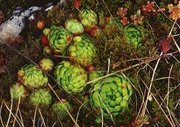Crassulaceae
|
|
| Crassulaceae | ||||||||||
|---|---|---|---|---|---|---|---|---|---|---|
| Missing image Money_tree_700.jpg Money tree Jade plant or Money tree, Crassula ovata | ||||||||||
| Scientific classification | ||||||||||
| ||||||||||
| Genera | ||||||||||
|
many, see text |
The Crassulaceae, or orpine family, is a family of dicotyledons. They store water in their succulent leaves. They are found worldwide, but mostly occur in the Northern Hemisphere and southern Africa, typically in dry and/or cold areas where water may be scarce. The family includes about 1,400 species in 33 genera.
Heuffrumaen.jpg
No member of this family is an important crop plant, but many are popular for horticulture; many members have a bizarre intriguing appearance, and are quite hardy, typically needing only minimal care. Familiar species include the Jade plant or "money tree", Crassula ovata.
Classification within the family is difficult because many of the species hybridize readily, both in the wild and in cultivation. Some older classifications included the Crassulaceae in the Rosales, but newer schemes treat them in the order Saxifragales.
CAM photosynthesis (Crassulacean Acid Metabolism) is named after the family, because the pathway was first discovered in crassulacean plants.
Genera
- Adromischus
- Aeonium
- Aichryson
- Cotyledon
- Crassula
- Dudleya
- Echeveria
- Graptopetalum
- Greenovia
- HylotelephiumMissing image
Hirtum.jpgFlowering Sempervivum hirta subsp. hirta (syn. Jovibarba globiferum subsp. hirtum) - Hypagophytum
- Jovibarba
- Kalanchoe
- Lenophyllum
- Monanthes
- Orostachys
- Pachyphytum
- Perrierosedum
- Phedimus
- Pistorinia
- Prometheum
- Pseudosedum
- Rhodiola
- Rosularia
 Sempervivum sobolifera (syn. Jovibarba globiferum subsp. globiferum), Hen and chicks
Sempervivum sobolifera (syn. Jovibarba globiferum subsp. globiferum), Hen and chicks - Sedum
- Sempervivum
- Thompsonella
- Tylecodon
- Umbilicus
- Villadia
See also
References
- Urs Eggli, ed. Illustrated Handbook of Succulent Plants: Crassulaceae (Springer, 2003) ISBN 3-540-41965-9da:Stenurt-familien (Crassulaceae)
de:Dickblattgewächse es:Crassulaceae eo:Krasulacoj fr:Crassulaceae no:Bergknappfamilien
